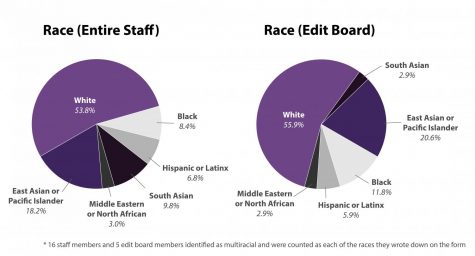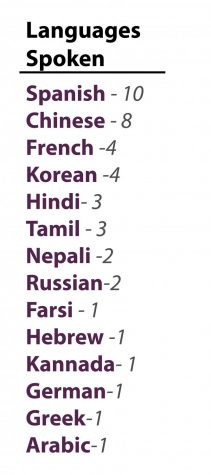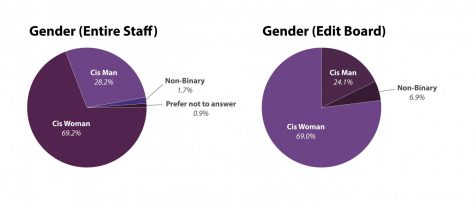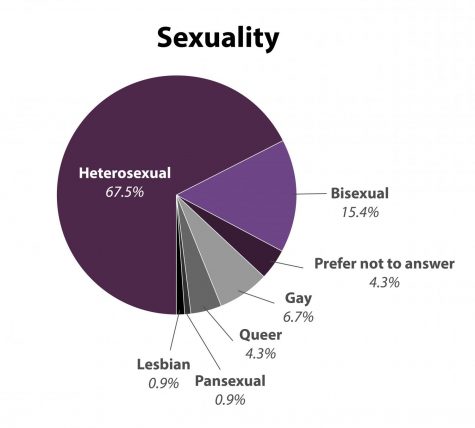The Daily Northwestern’s Fall Quarter 2020 Diversity Report
November 19, 2020
Historically, our newsroom has not represented our campus. The identities present on staff affect every aspect of our work, from the themes we choose to highlight, to the ways we engage with our sources, to the words we put on paper.
In 2018, we started releasing an internal survey of our staffers, in an effort to be more accountable about the diversity of our newsroom.
For the past three years of publishing these diversity reports, we have traditionally released our newsroom’s demographic breakdown at the end of each Spring Quarter. However, as academic and extracurricular commitments fluctuate from quarter to quarter, our staff members often shift in and out of the newsroom. To ensure we remain as transparent as possible about our composition, we are now publishing staff diversity reports at the end of each quarter.
Releasing our demographics is only one component of the changes we’ve made to critically examine our newsroom and coverage. We are regularly reevaluating the way we report, write and produce content to ensure we are operating through a lens of diversity and inclusion, and that we are supporting the Northwestern and Evanston communities to the best of our ability.
It is also important to note that our staff is wrapping up its second quarter in a fully remote newsroom amid the coronavirus pandemic. COVID-19 has taken a severe physical, mental and financial toll on Northwestern students, who are also adjusting to the unique challenge of online learning and juggling school work with jobs, family obligations and other responsibilities. These pressures all factor into students’ decisions to participate. As we move into the Winter Quarter, we will continue evolving our team’s structure to grow The Daily into a more accessible and equitable place.
Staff participation in this survey increased since last Spring Quarter from a sample size of 94 to a sample size of 117. This rise is not unusual; we typically see an increase in staffers at the start of the academic year.
Survey Results
Race

Although our proportion of White reporters has decreased overall, White people remain the largest racial bloc of The Daily’s staff. Roughly 54 percent of our staffers identify as White.

East Asian, Pacific Islander and South Asian staffers make up the next largest share of our staff, together accounting for about 28 percent of students at the Daily. Black staffers are 8.4 percent of our team, and Latinx staffers 6.8 percent. Three percent of our staffers identify as Middle Eastern or North African. However, 13.7 percent of our staffers identify as two races or more. We have no staffers who identify as American Indian.
Our edit board’s racial demographics skew slightly differently than the rest of the staff. Almost 56 percent of our edit board identifies as White — an increase from Spring Quarter 2020 — and almost 24 percent identify as East Asian, Pacific Islander or South Asian. Almost 12 percent of our board identifies as Black, 5.9 percent identify as Latinx and 2.9 percent identify as Middle Eastern or North African. Five edit board members out of 28 identify as multiracial.
In comparison, about 56 percent of Northwestern’s Class of 2022 identifies as White, and about 24 percent of those students identify as Asian or Pacific Islander, according to Northwestern’s 2019 diversity report. While our staffer who hold these identities exceed the proportion of White, Asian and Pacific Islander students at Northwestern, we have a significantly lower share of Black and Latinx staffers. We are not close to achieving full representation on staff, but we have seen a mild increase in the proportion of Black and Latinx members of our team since we reported our metrics last Spring Quarter.
Heading into Winter Quarter, Sneha Dey will lead The Daily as a South Asian female editor-in-chief, becoming the fourth consecutive EIC who identifies as a person of color after a century of overwhelmingly White leadership. But representation within senior leadership does not equate to representative coverage. While leadership can push for diverse coverage, recruitment and retention, our whole newsroom is responsible for the content we create and the relationships we build. There is power in fostering safe and welcoming environments for reporters of color, and there’s still a lot of work for us to do.
Gender and Sexuality

Since we started collecting metrics, The Daily has been a largely woman-identifying space. This year, we noted a significant increase in our proportion of female staffers, rising from 64.9 percent to 69.2 percent since last Spring Quarter. Almost 7 percent of our editorial board identifies as non-binary, but our non-binary staff remain highly underrepresentative of the campus population, comprising just 1.7 percent of our team. We have also noted that a markedly low proportion of our coverage this quarter includes transgender and gender-noncomforming people, which could relate to the gender composition of our staff. We are working to more intentionally report with non-cis identities in mind, but we have far to go to increase gender diversity in both our staff and our coverage.

Our proportion of queer staffers has dipped slightly since last Spring Quarter. About 28 percent of our staff this quarter identifies as LGBTQ+, down from 30.9 percent last spring. However, this share is still slightly larger than the total representation of LGBTQ+ students on campus — about 25 percent, according to a 2020 Associated Student Government analytics survey. While we do have a large proportion of queer staffers, we have room to grow with our LGBTQ+ coverage in some desks.
Economic Status
Last year, 7.4 percent of staff were first-generation students. This year, that share has lowered to 6.8 percent. Additionally, our proportion of students who receive financial aid falls around 45 percent — over 15 percent lower than the campus-wide proportion of 61 percent.
FGLI representation on staff increased last year following the introduction of the McCormick scholars program in Fall Quarter 2019, a quarterly stipend awarded through Medill to reduce some of the barriers to reporting. However, we are certainly far from where we should be in our inclusion of FGLI staffers, and we are taking strides to make our newsroom a more accessible and welcoming place for these students.

Our Coverage
Metrics are a useful data point, but they do not tell the full story of our staff or our coverage.
In our City and Campus desks, we’ve seen a notable increase in the proportion of our sources who identify as Black. This rise follows Northwestern Community Not Cops beginning its series of daily actions, as well as Black Lives Matter events happening regularly in Evanston. While it is crucial that we keep covering these stories, we also must actively ensure that we are reporting BIPOC narratives outside of breaking news events as well. This goes for desks beyond our City and Campus staff, like Sports and Arts & Entertainment.
While our city coronavirus news grew more diverse last quarter, covering communities we did not write about as frequently in previous years, the topics we wrote about in the Fall were less inclusive than we would have liked. Factors outside of our control, like slow FOIA responses, digital limitations due to the pandemic and obstacles in getting interviews are important to note — but we are still committed to increasing our scope of reporting in Evanston.
As we look ahead, we remain committed to expanding and diversifying our coverage by reaching out to life-giving student organizations and enriching staffers’ experiences from within.
We urge other college publications, both at Northwestern and around the nation, to critically assess their newsrooms and publish similar reports as a part of an active effort to better serve their communities and staffers.

